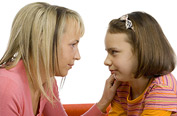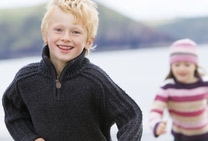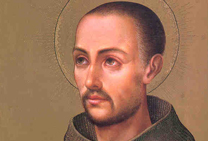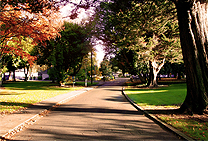YOU ARE HERE: Home
> Info for Parents > Obsessive Compulsive Disorder
Obsessive Compulsive Disorder

Joan’s Story
Joan was a 9 year old girl in third class who became quiet and withdrawn in school and seemed to be very slow at completing all her academic tasks. She confided in her teacher that when writing she had to write every seventh word out seven times before she could write the next word. If she stopped before her homework was completed she had to start at the beginning again. This lasted for hours. If she ever touched someone as she passed them she needed to touch them back twice immediately or she would become very distressed. She could not explain why she had to do this, knew it was “silly”, but did not “feel right” until she did it.
What is Obsessive Compulsive Disorder (OCD)?
OCD is a disorder characterised by recurrent intrusive thoughts, images and impulses or compulsive behaviours that cause marked distress and/or interference in a person’s life.
How is Obsessive Compulsive Disorder diagnosed?
Many young children (and indeed adults) have some obsessional behaviour such as not standing on cracks, not allowing themselves walk under ladders or always needing to sleep with a certain object. Many of these are superstitions and are carried out or adhered to to avoid some unpleasant event or consequence, such as bad luck after walking under a ladder. These behaviours are developmentally appropriate, generally decrease as the child gets older and do not cause significant upset. Some individuals may continue to be somewhat obsessional as they grow older - putting items away in a predefined order, fastidious cleaning, attention to detail. Such behaviour is benign and may be beneficial.
Obsessional thoughts or behaviours that lead to significant distress and interfere significantly with the individual’s emotional, academic or family life are characteristic of OCD. Obsessions can be in the form of involuntary thoughts, urges or impulses. The main features of obsessions are that they are frequent, automatic and very anxiety provoking.
Obsessions commonly include a fear of dirt, germs, fear of acting violently or an unreasonable fear of harming others. Compulsions are rituals that a child feels compelled to carry out. It is common for people to carry out a compulsion in order to reduce anxiety experienced from obsessive thoughts. Compulsions can be observable actions such as excessive hand washing or mental rituals such as repeating certain words, counting or praying.
What signs should I look out for?
Children may repeatedly wash their hands to prevent ‘something bad happening’;
Some children may avoid certain situations or seek reassurance repeatedly;
The child may become very anxious if the compulsion is not carried out. The following are common compulsions:
- repeating actions including: checking, touching, counting, ordering and arranging;
- A child handing in homework late which may have been rubbed out or corrected excessively;
- A need to have things ‘just right’, a need for symmetry when washing, walking, or touching.
What are the effects of OCD?
OCD can cause severe disruptions to academic performance, peer relationships and family functioning. Family members often become involved in maintaining the rituals of the OCD. For example, a child may repeatedly ask parents for reassurance regarding ‘cleanliness’. This can culminate in parents becoming participants in elaborate rituals such as washing the child in a certain way for hours at a time, according to certain ‘rules’ . The OCD can become so dominant in a child’s life that going out with friends is avoided due to time spent on rituals. Children with compulsions about cleaning may end up with sores and excoriations due to repeated washing. Parents may feel increasingly helpless as to how to prevent the behaviour from escalating or may react to demands to participate in rituals in different ways, which can lead to increased tension in the family.
Can anyone develop OCD?
Approximately 1 in 200 children and adolescents develop OCD. However, many children are ashamed and keep their symptoms of OCD a secret so the rates may be higher. Research has demonstrated that OCD is more common in boys with a ratio of approximately 2:1 (male to female).
Is OCD a ‘new phenomenon’?
OCD has been described since the 17th century, when obsessions and compulsions were often described as being associated with religious melancholy. The Oxford Don, Robert Burton reported a case in his compendium, “The Anatomy of Melancholy” of a man who was afraid that he would unintentionally speak ‘indecent thoughts’ out loud. In the 19th century modern concepts of OCD evolved.
What causes OCD?
In some cases OCD may be linked with an underlying biochemical imbalance. It is thought that there may be insufficient levels of the chemical serotonin in the brain. However, this does not fully explain the symptoms. OCD can occur as a result of streptococcal infections. This is called Paediatric Autoimmune Neuropsychiatric Disorders Associated with Streptococcal infections” or PANDAS. OCD may also occur with various neurological conditions including brain tumours, carbon monoxide poisoning, post-viral encephalitis, or rarely, an allergic reaction to a wasp sting.
Genetic Factors
The tendency to develop this disorder involves complex genetic and environmental factors. At least 50% of children with Pteriidae’s Syndrome (a disorder characterised by both motor and vocal tics) develop obsessive compulsive symptoms by adulthood. 60% of children with OCD have a history of Tics (see Chapter 11). First degree relatives show an increased rate of Tic and OCD disorders based on twin and family studies. This implies that there is a definite genetic component in some cases of OCD and a link between OCD and Tic Disorders.
Familial Factors
Research suggests that in some cases children with OCD come from families where parents are somewhat over-involved in managing their children. The home environment may be very tightly controlled. It is hypothesised that some children display similar behaviours to parents who may have obsessive traits themselves. Therefore, in these cases the link may be genetic or the child’s OCD may have developed in the context of modelling from parents. Parents do not cause OCD in their children as the development of the illness is multifactorial.
Cultural Factors
OCD occurs in all cultures but is reported to be more common in Caucasian children. The reasons for this are unknown.
When is professional help needed?
If the child’s obsessive thoughts or compulsive behaviours are impairing social, academic or family functioning, professional help may be required. Parents should bring the child to their GP initially who will then refer to CAMHS if appropriate.
Treatment
Education and support are very important for the child, parents and teachers. The child should have a full medical examination to rule out any medical cause for OCD. Following this a child should be referred to the local CAMHS team or psychology service for treatment. It is important to watch out for Depression or Tic Disorders as often young people have more than one disorder. Usually the treatment is carried out in an outpatient department. However, if a child is extremely distressed by symptoms or very impaired in everyday life, more intensive input from a Child and Adolescent Day Hospital or an inpatient unit may be necessary.
Cognitive Behavioural Therapy
Cognitive Behavioural Therapy is the treatment of choice for children with OCD as research studies have established its effectiveness. Therapy typically begins with a detailed assessment of the thoughts and behaviours which are problematic. This may be done by the child and family keeping a diary of obsessions and compulsions. Each obsession and compulsion is then placed into a ‘hierarchy’. The place of each symptom on the hierarchy is based on the distress the child experiences in response to the specific obsession or compulsion.
Frequently the next step in therapy is to teach the child how to identify anxious feelings and how to use relaxation techniques and deep breathing. This will prepare the child for the next step and allow the child to participate in various “behaviour experiments” which are crucial to the successful management of OCD. For example, if a child has a fear of germs, ‘germs’ must be faced in multiple guises. This is organised in a stepwise fashion. The child may first have to think about germs and then draw germs and finally build up to touching a feared ‘dirty’ object. At each step, the child is supported to overcome anxiety and helped not to engage in compulsive behaviour (despite the anxiety this provokes). Learning how to confront the anxiety caused by engaging in compulsive behaviours is key to treating symptoms of OCD. The child is helped to develop a ‘toolkit’ which consists of alternative positive coping strategies which can be utilised when experiencing an obsession or compulsion.
Medication
A child who is not responding to CBT may need medication. A number of studies have shown that for moderate or severe OCD, the best treatment is a combined approach using both medication and CBT. The medications that are useful in treating OCD act in the brain to increase a chemical called serotonin. Most commonly either Fluoxetine (Prozac) or Sertraline (Lustral) is used; these are also used to treat Depression. Many children do not show an improvement in their obsessive compulsive symptoms until they are on the
medication for six weeks.
Family Work
Parents are advised to help children not to become involved in elaborate time consuming rituals. They can help children use distraction and relaxation techniques. Some children become very distressed if they are interrupted carrying out their ritual. Families need to be careful that they do not become extensively involved either in the child’s compulsive rituals or in reassuring the child’s obsessional worries as parents may inadvertently perpetuate the child’s behaviour. It is important to try and maintain a calm and supportive environment.
Resources
Useful Websites
Obsessive-Compulsive Anonymous. P.O. Box 215, New Hyde Park, NY 11040. (516)741-4901. west24th@aol.com http://members.aol.com/west24th/index.html info@ocdireland.org
Books
The Sky is Falling: Understanding and Coping with Phobias, Panic and Obsessive-Compulsive Disorders. Dumont, Raeann. New York: W. W. Norton & Co., 1996.
‘Kids Like Me’ - Children’s stories about Obsessive Compulsive Disorder, Constance Foster. 1997
Obsessive-Compulsive Foundation. P.O. Box 70, Milford, CT 06460. (203) 874-3843. JPHS28A@Prodigy.com http://pages.prodigy.com/alwillen/ocf.html
Swedo, S. E., and H. L. Leonard. It’s Not All In Your Head. New York: HarperCollins, 1996.










